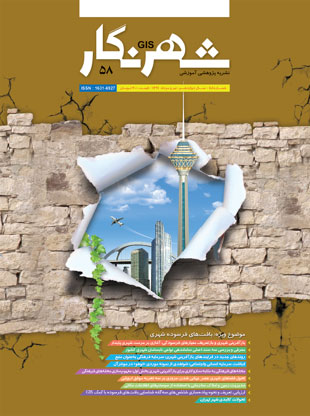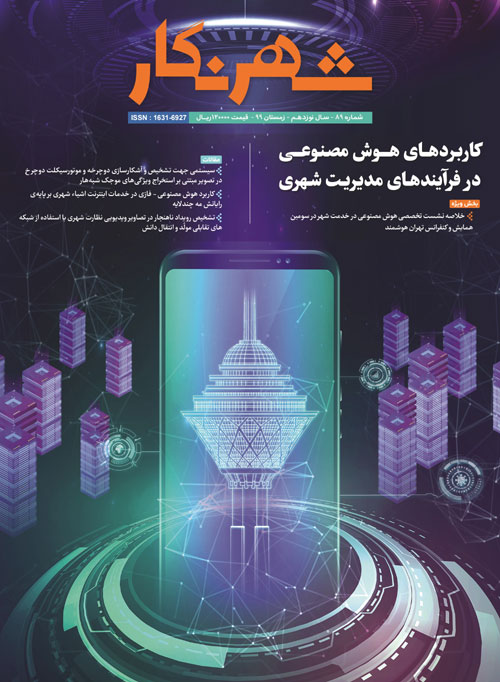فهرست مطالب

دو ماهنامه شهرنگار
پیاپی 58 (تیر و امرداد 1391)
- 198 صفحه، بهای روی جلد: 20,000ريال
- تاریخ انتشار: 1391/06/01
- تعداد عناوین: 18
-
صفحه 2
- بخش ویژه: بافت های فرسوده شهری
- دیدگاه
-
صفحه 117
- بخش GIS و تکنیک های برنامه ریزی و طراحی شهری
-
صفحه 134
-
صفحه 143
-
صفحه 157
- بخش رویدادهای علمی و اجرایی
-
صفحه 166
-
صفحه 173
-
Page 14Urban regeneration study as an urban-oriented activity in present fabrics of the city could get various directions. Revolving around the trilogy concept of ‘reconstruction, renovation and regeneration’, major share of available literature review in conjunction with urban renovation concerns methods of fabric intervention as well as methodology of urban renovation process for eliminating or restoring decaying signs. Through such a view, criticism of urban renovation activity mostly regards this process’ circumstances and its side effects in planning condition or inappropriate execution. If one admits the trilogy concept as an efficient and updated version, then it could be mentioned that there existed an intention for seeking citizen participation methods for the purpose of urban plans’ success and facilitation. Since stipulation of urban physical fabrics criteria namely urban undersized grain, impermeability and structure instability for identification of urban decaying fabrics by Higher Council of Architecture and Urban Planning on 1/5/2006, the question arose is how to get closer to the multiple dimension of decay concept by redefinition or development of these criteria, and how to redefine it by delimiting a realistic framework including physical and spiritual context of the city. Looking in depth to the characteristics of urban regeneration reveals that regeneration is the process thatconsistently seeks elimination of decay through physical and nonphysical interventions in urban fabrics. Therefore perception of decay shall play an important role to find a solution. It may also lead to definite strategy to view the urban fabrics and the extent of intervention.Keywords: Urban Regeneration, Decay, Urban Praxis, Life Quality, Sustainable Development
-
Page 26This paper firstly attempts to reintroduce the most important documents and present legislations in rehabilitation of problematical urban areas of Iran that are provided in the past half of century. Among these documents and legislations, there are three main ones which are expounded. As the objective of this paper is to reintroduce these documents, it does not criticize them and shall not carry out a survey in detail. Overall, in spite of provision of important documents as well as actions for unorganized urban areas, there is yet a methodological and strategically approach suitable for various patterns of unorganized urban areas regardless of having regulations and acts in common. The same is true with the fact that the urban communities have no impact in provisions of those regulations in general sense. Through such stance, reintroduction of these documents prepares the platform for wide range of urban actors to engage in criticismKeywords: Documents, Legislations, Unordered Urban Areas, Various Patterns, Iran
-
Page 99Urban spaces in the globalization era have turned to be of the imperative factors in improvement of public realm quality as the result of both return of beauty to the city and success in promotion of city competitiveness level. In this sense, municipalities and urban governments attempt to attract floating capitals in globalization era by investing in development of urban public spaces. This paper attempts to deal with the necessity of consideration that must be taken to the change of urban spaces in globalization era by investigating three European relatively successful case studies namely La Défense of Paris, Canary Wharf of London and PotsdamerPlatz in Berlin.Keywords: Urban spaces, Globalization, La Défense, Canary Wharf, PotsdamerPlatz
-
Page 119Nowadays, the land and its management are of the key debates which concern both governmental and nongovernmental bodies in many countries. This is because the land deemed to be unique goods with increasing importance as the result of the infeasibility of reproduction. In this regard, property plurality in these organizations causes difficulties in integrated management due to information dispersion in various realms. This not only impedes thorough monitoring of such properties but also leads to higher expense and time consumption and even illegitimate possessions and law related issues for that organizations. The objective of this paper is to conduct a survey on managerial systems and methodologies as well as proposing solutions for optimized property management by the organizations with the aid of Geographical Information Systems (GIS). The results show that application of GIS can have a significant role in optimized management of an organization property provided that it associates with analysis of geographical as well as descriptive and legislative information. Furthermore, this research proposes a framework for land management decision-support-system in large organizations and corporations.Keywords: Land Management, Geographical Information System, Land Information Systems, Cadastre
-
Page 128The subject of decaying fabrics has been debated in urban management, academia and urban professionals from its general terms views. The concepts of decaying, problematic and vulnerable urban fabrics includes an extensive spectrum of physical, social, economic, environmental and even management dimensions. This paper will concentrate on lawful definition of decay indices as well as its implementation methods by the aid of Geographic Information System. The results show some hurdles in identification methods that are counted as the challenges today for decaying urban fabrics. Furthermore, the proper method selection for identifying decaying fabrics with the aid of Geographical Information System can encounter lower level of error.Keywords: Decaying Fabrics, Decay Indices, Instability, Urban Grain, Geographical Information System
-
Page 134Urbanism, development of urban areas and expansion of metropolitan areas are of the most important characteristics of developing countries where Iran is no exception. In this sense physical development of Metropolis of Tehran has been accelerated in past few decades. In spite of attempts made to illustrate this development, yet application of appropriate techniques as well as data can improve provision of the trend. Hence, physical expansion of Tehran prior to 1891 has been extracted by the aid of ‘Change Detection’ technique and in accord to the historical documents, aerial photos and satellite imageries. The results show that physical development of Tehran Metropolis in various periods has been influences by the economic and political situation of ruling government; however the peripheral development of Tehran city has been accelerated since 1996 in comparison to the last decade that leads to rapid development of small settlements around the Metropolis. Furthermore, data extraction from various resources has shown the level of city’s development as well as the area development ratio in each period.Keywords: Physical Development, Population Changes, Change Detection, Image Processing, Tehran Metropolis


